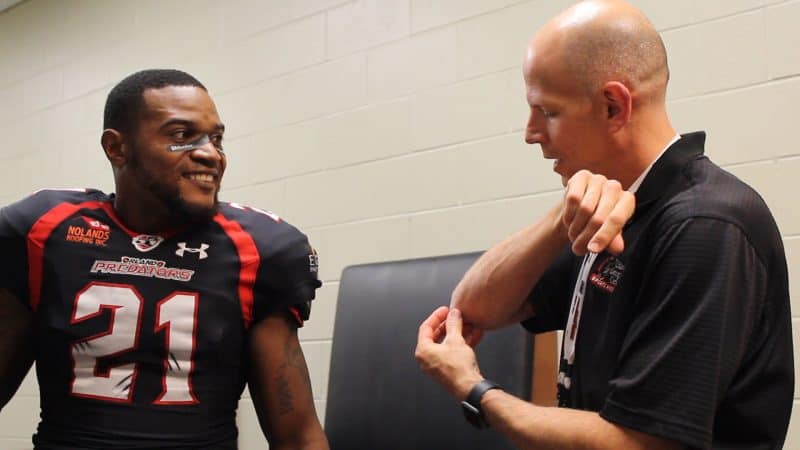What Is a Biceps Tendon Injury?
Located at the front of the upper arm, the biceps muscle helps lift the arm straight up, bend the elbow, and provides stability for the shoulder. Injuries to the biceps tend to occur in one of two places: the shoulder or the elbow.
“The biceps is the main muscle on the front of the arm. Two heads come off the shoulder and one tendon inserts onto the elbow,” explains Bryan L. Reuss, M.D., a double board-certified orthopaedic surgeon specializing in sports medicine at Orlando Orthopaedic Center. “This helps to supinate and flex the elbow.”
Although relatively uncommon, the biceps muscle can suffer a partial or even a complete tear.
There are two leading causes for a biceps tendon tear: injury and overuse. Injury usually occurs with a hard fall on when lifting a heavy object. The majority of biceps tears are the product of wear and tear on the tendon, which occurs naturally as people age (overuse). Consistently repeating the same shoulder movements can lead to an array of issues, including tendonitis, shoulder impingement or rotator cuff damage. These conditions place additional stress on the tendon and increase the likelihood of a tear.
Symptoms of a biceps tendon rupture may include:
- A “pop” sound when it happens
- Severe pain at first that subsides after a week or so
- Swelling in front of the elbow
- Sensation of weakness in bending or supinating the elbow
- Visible bruising in the elbow and forearm region
- A noticeable gap in front of the elbow that results from the absence of the tendon
 “When the bicep is ruptured or torn at the elbow level it needs surgery, or else the patient will lose functions like supination and flexion strength,” says Dr. Reuss. “Sometimes the biceps is ruptured in the shoulder and results in a Popeye deformity (an abnormal shortening of the biceps muscle).”
“When the bicep is ruptured or torn at the elbow level it needs surgery, or else the patient will lose functions like supination and flexion strength,” says Dr. Reuss. “Sometimes the biceps is ruptured in the shoulder and results in a Popeye deformity (an abnormal shortening of the biceps muscle).”
For many patients with shoulder-originated biceps tears, the pain clears up over time. In other cases, mild residual arm pain or deformity may not bother individual patients, such as older or less active individuals.
Conservative treatment options for a biceps tendon tear may include:
Ice. Applying a cold pack for twenty minutes at a time a few times each day can help address pain and swelling.
Nonsteroidal medication. Over-the-counter medicines like ibuprofen, aspirin or naproxen can help decrease inflammation and discomfort.
Rest. Activities that exacerbate the injury or involve reaching overhead or heavy lifting should be avoided.
Physical therapy. Patients should seek treatment from a licensed physical therapist to restore strength, flexibility, and range of motion.
What Can I Expect from Biceps Tear Surgery?
Patients with more severe biceps shoulder tears or athletes who need to return to full form may require surgery.
“There are two heads (of the biceps) in the shoulder, so many times the biceps injury doesn’t need to be corrected,” says Dr. Reuss. “But if a patient does have a lot of weakness, pain or deformity and wants to have it fixed, it can be repaired in a similar manner as the elbow with a screw.”
For those patients choosing surgery, orthopaedic sports medicine specialists typically suggest performing the procedure within the first two to three weeks following the injury. After that point, the tendon and muscle in the bicep can begin to scar and shorten, making the restoration of arm function more difficult or even impossible.
To reattach the tendon to the forearm bone, an orthopaedic surgeon will make an incision at the front of the elbow or use small incisions at both the front and back of the elbow. The tendon is attached with stitches through holes drilled in the radius (forearm) bone, or it may be connected to the bone using suture anchors, or small metal implants.
Following surgery, the patient’s arm is usually immobilized in a cast or splint. Physical therapy is regularly prescribed to help patients regain range of motion, strength, and flexibility. Resistance exercises can be gradually added to the rehabilitation plan. Staying committed to one’s rehabilitation plan is vital for achieving a full recovery.
An average recovery takes about three months, and by the time patients reach their final check-up, most have regained full range of motion and strength.
“The outcomes typically are very good,” says Dr. Reuss. “Patients regain their strength and usually recover within three months to get back to their normal function and sporting activities.”


